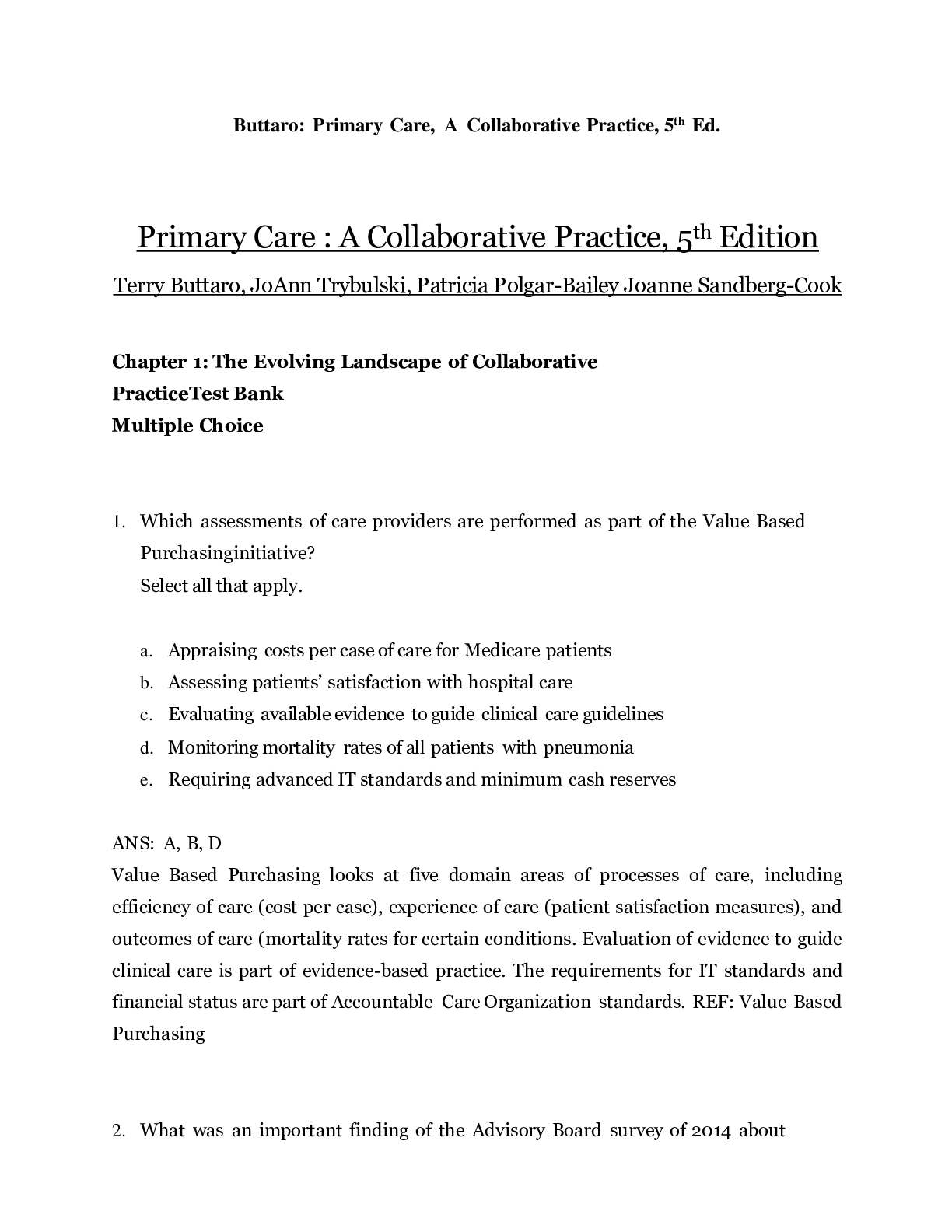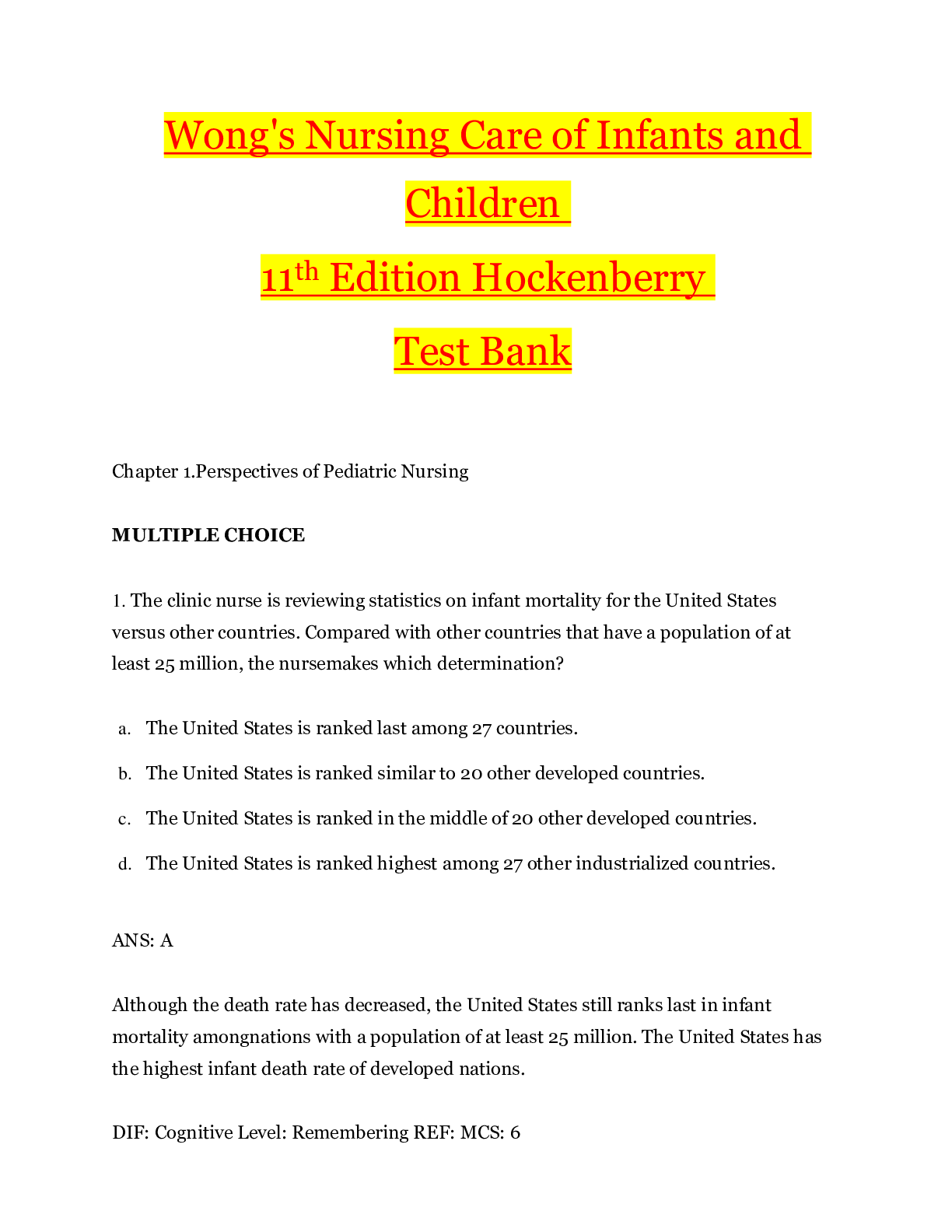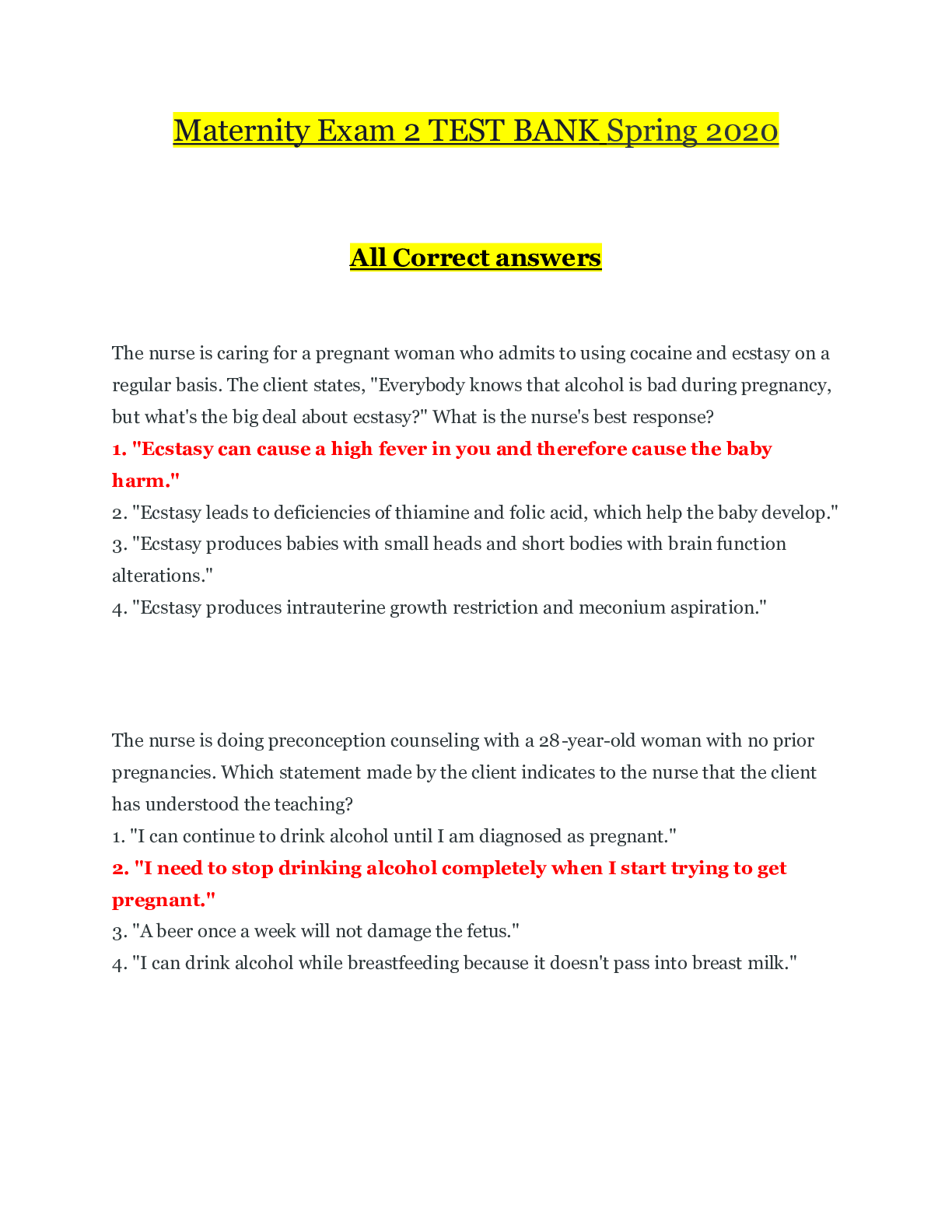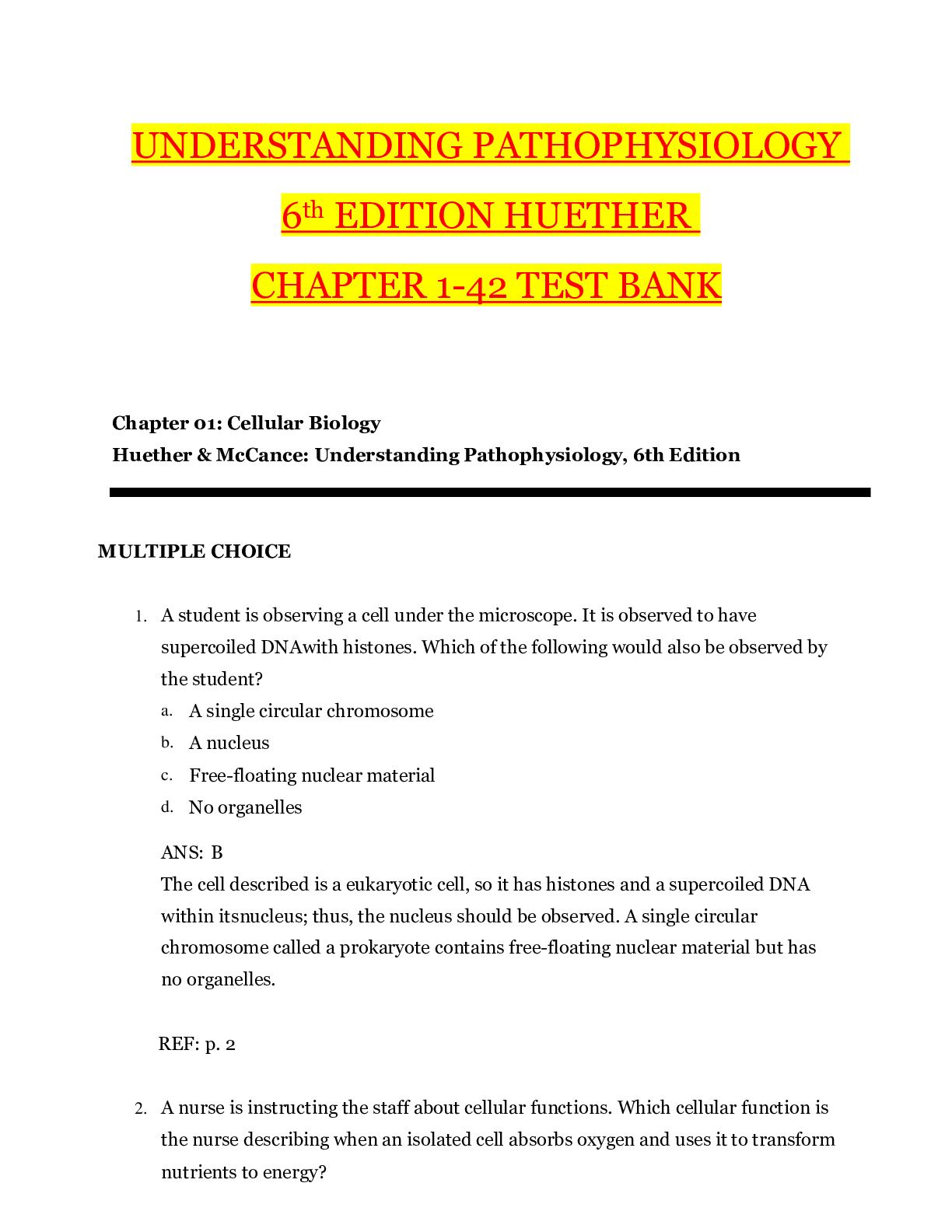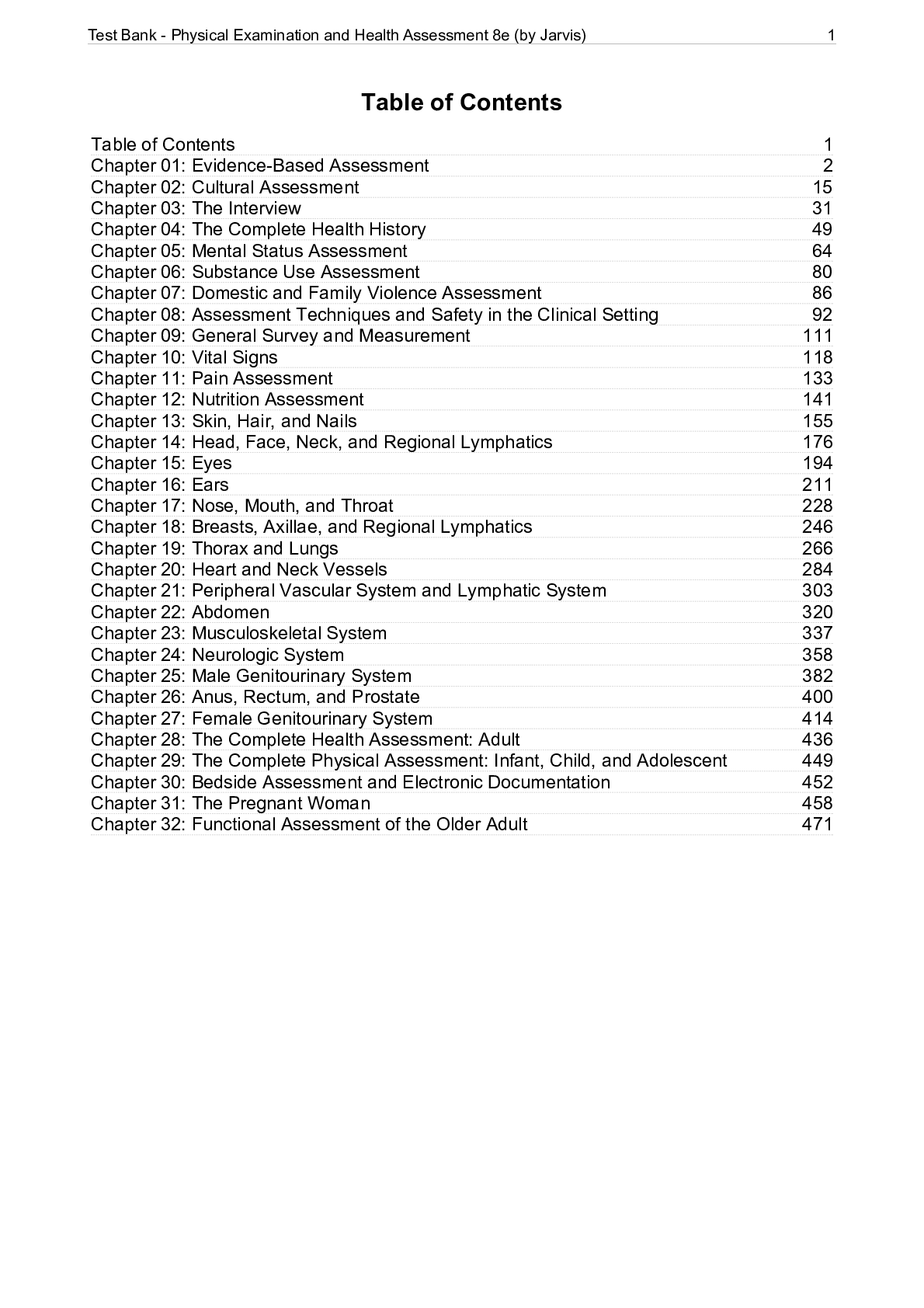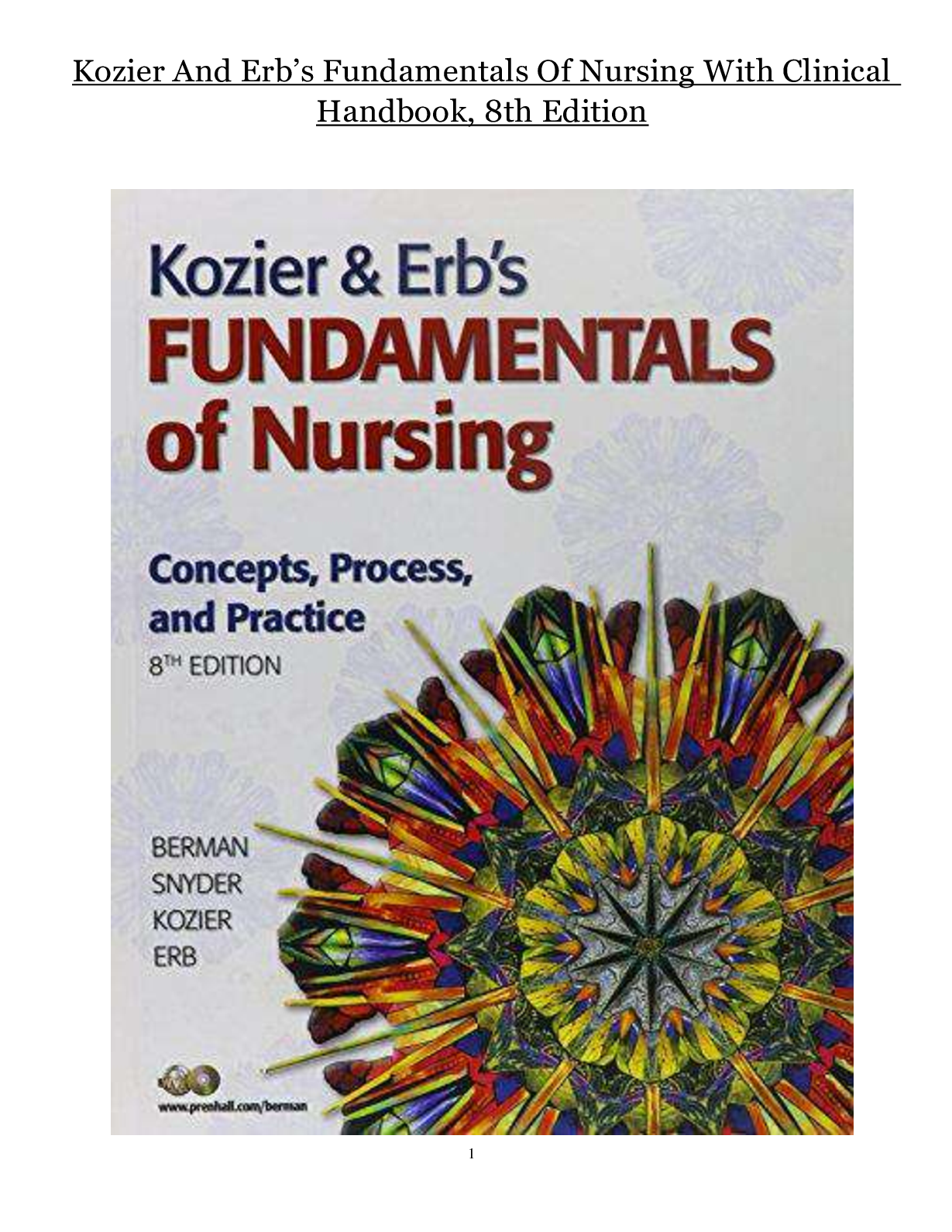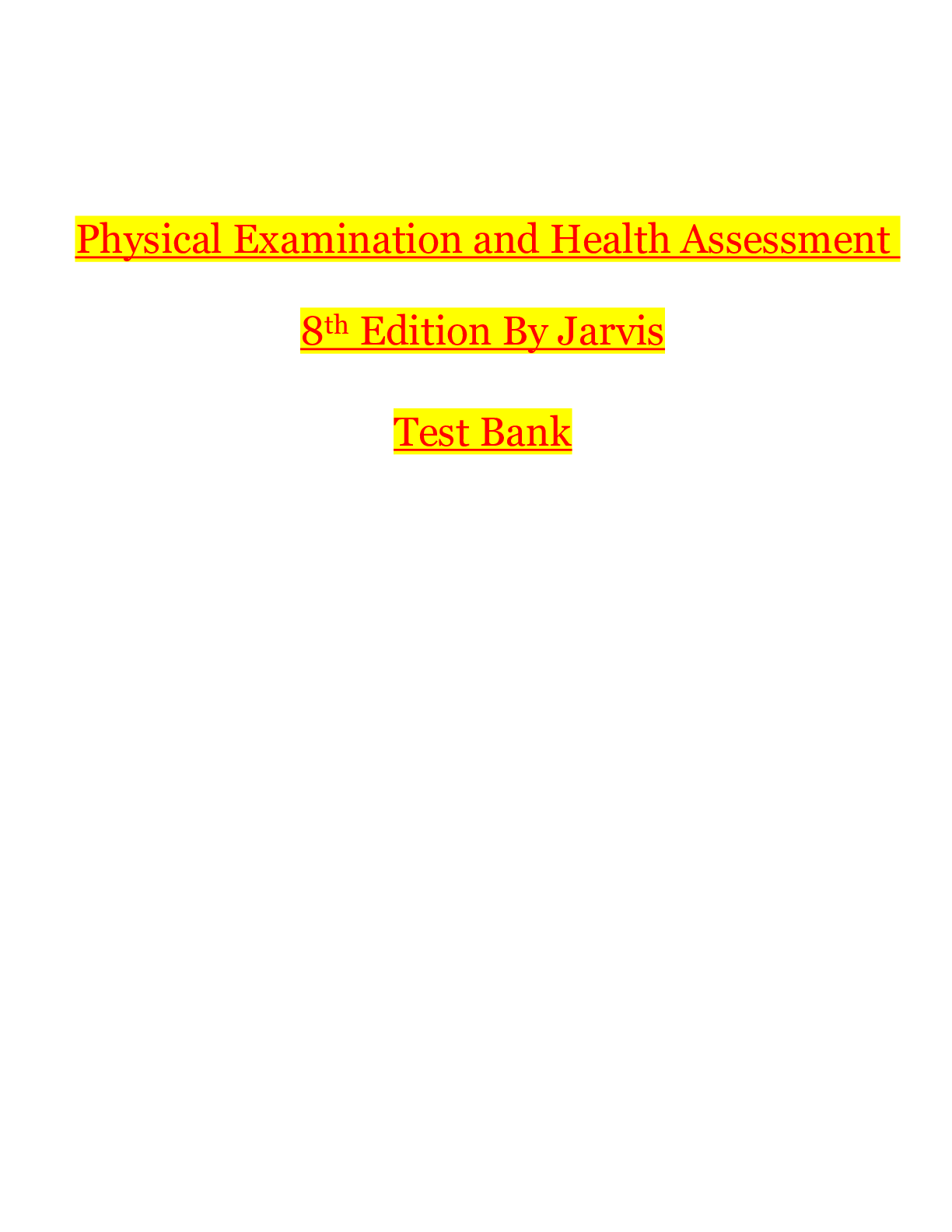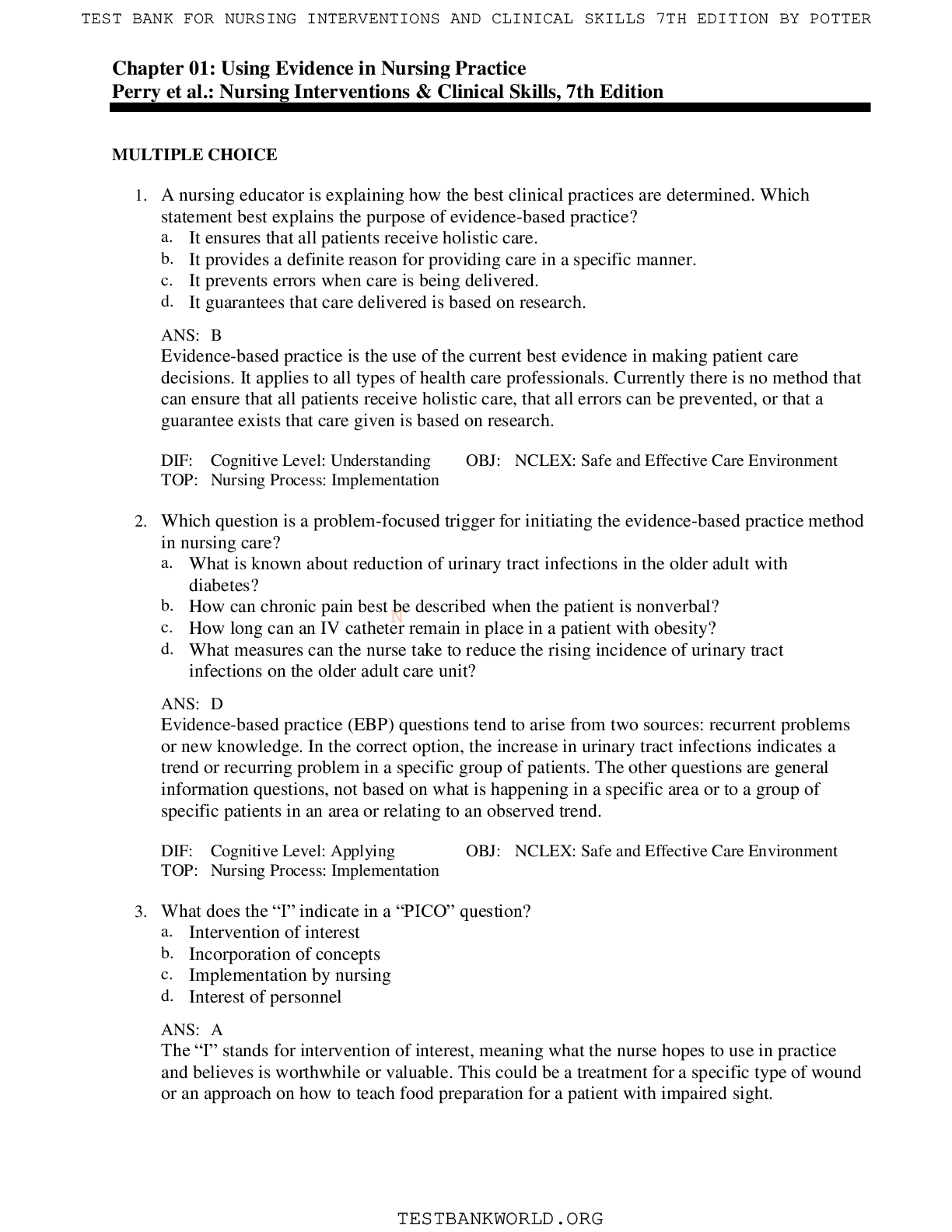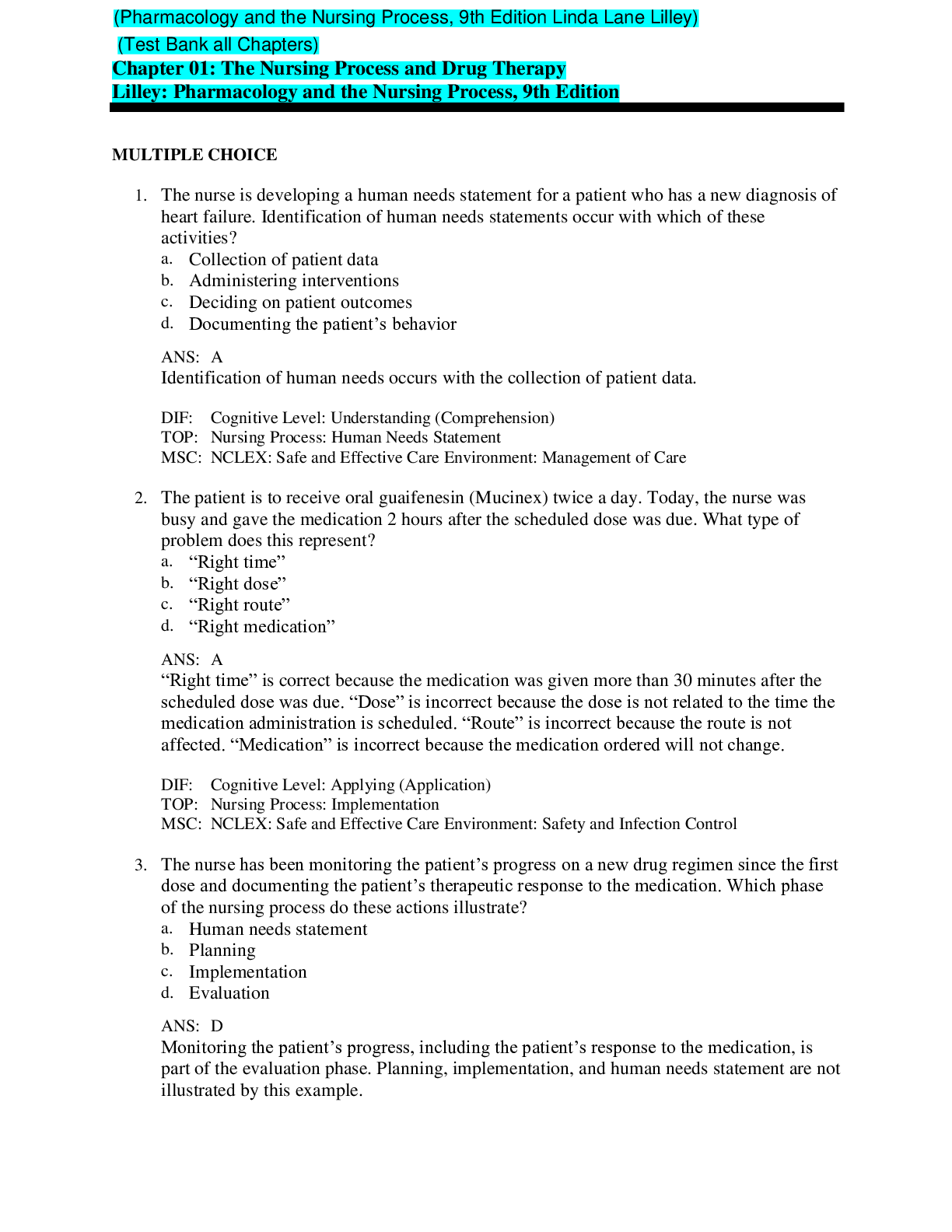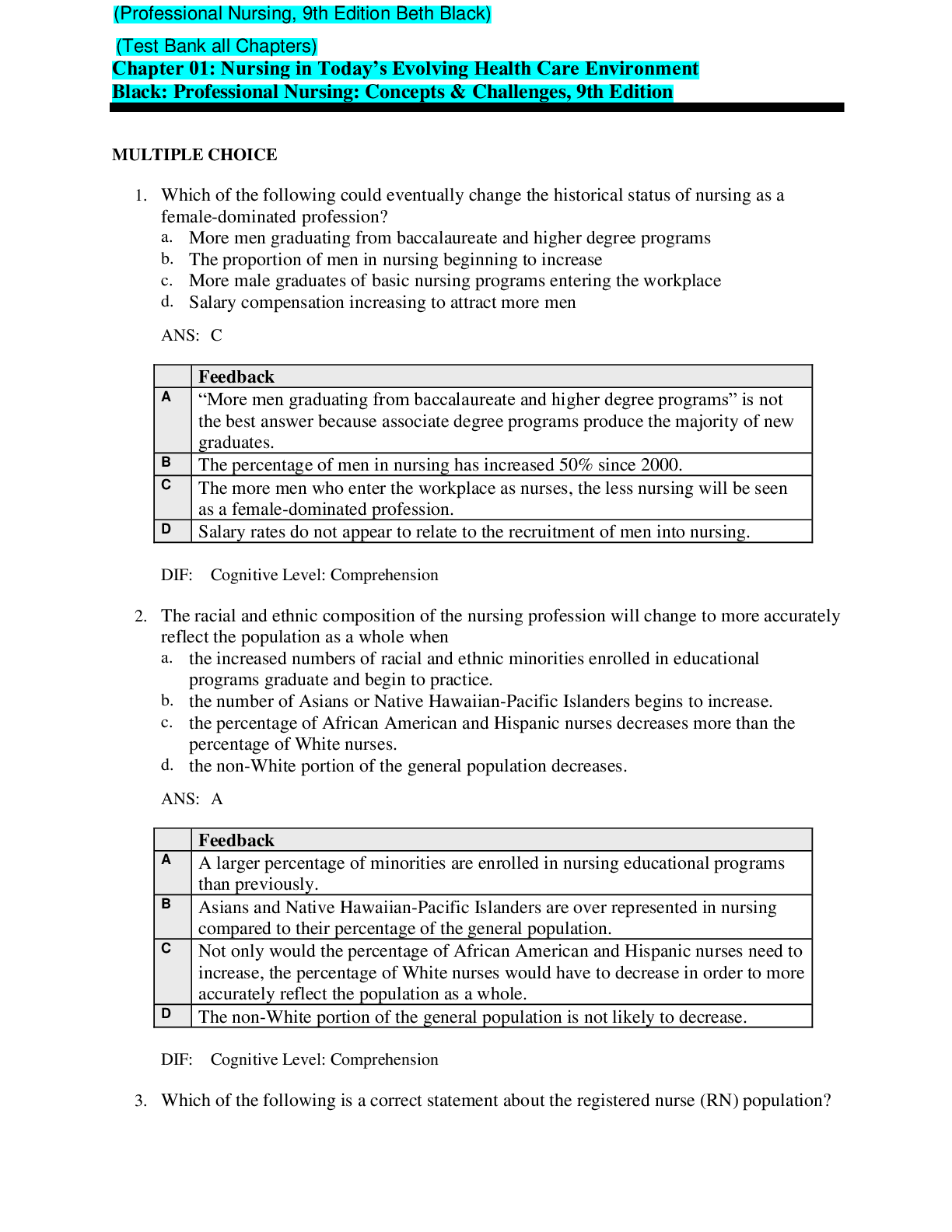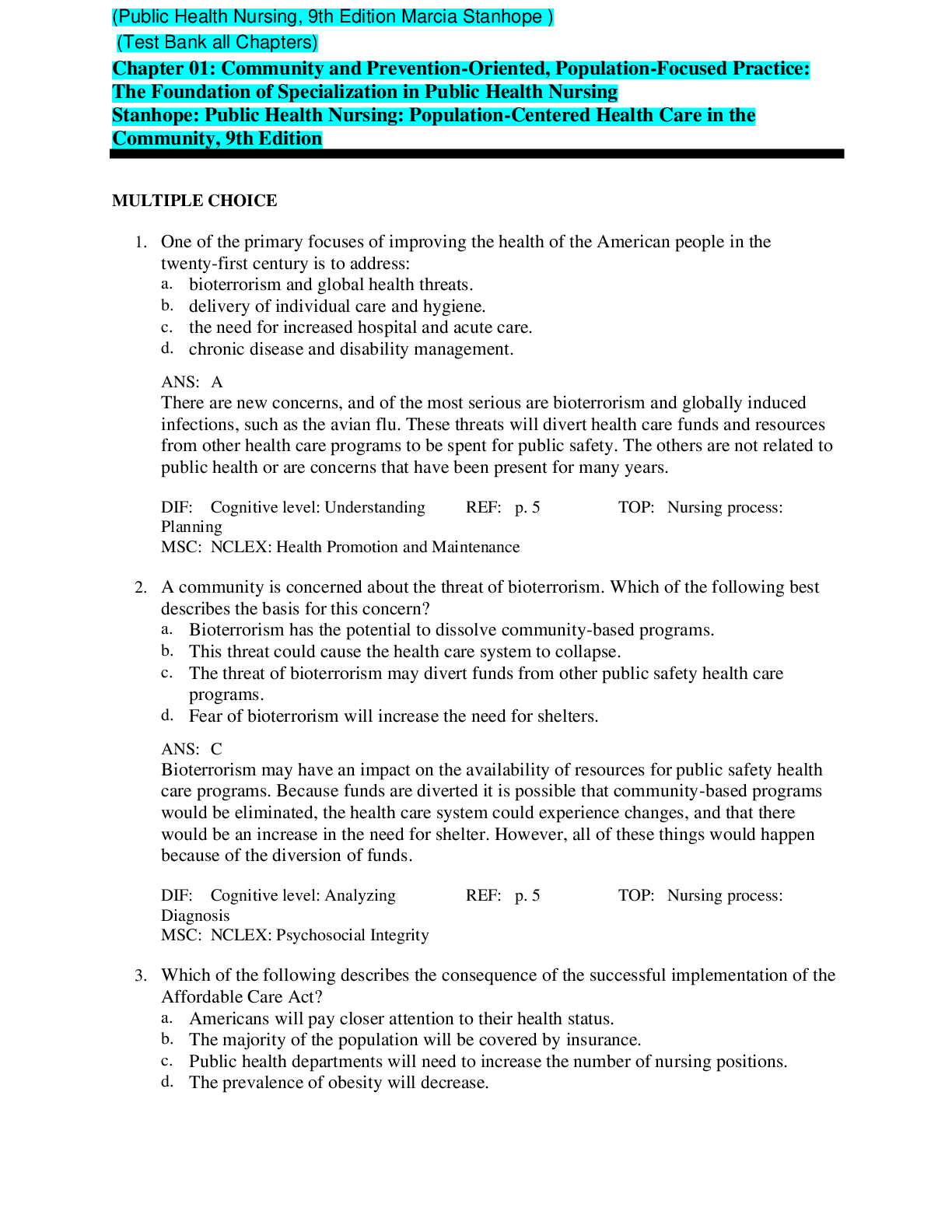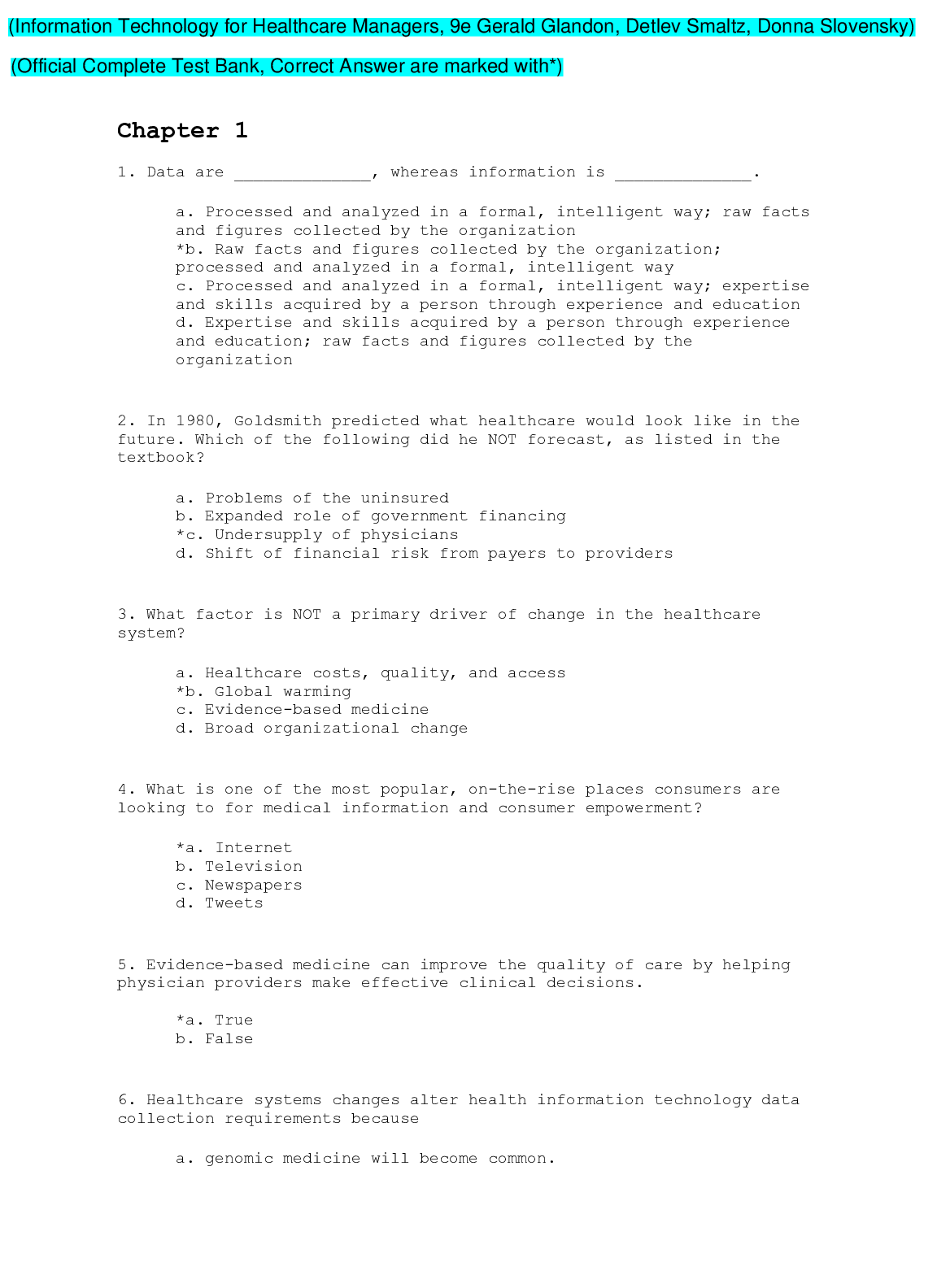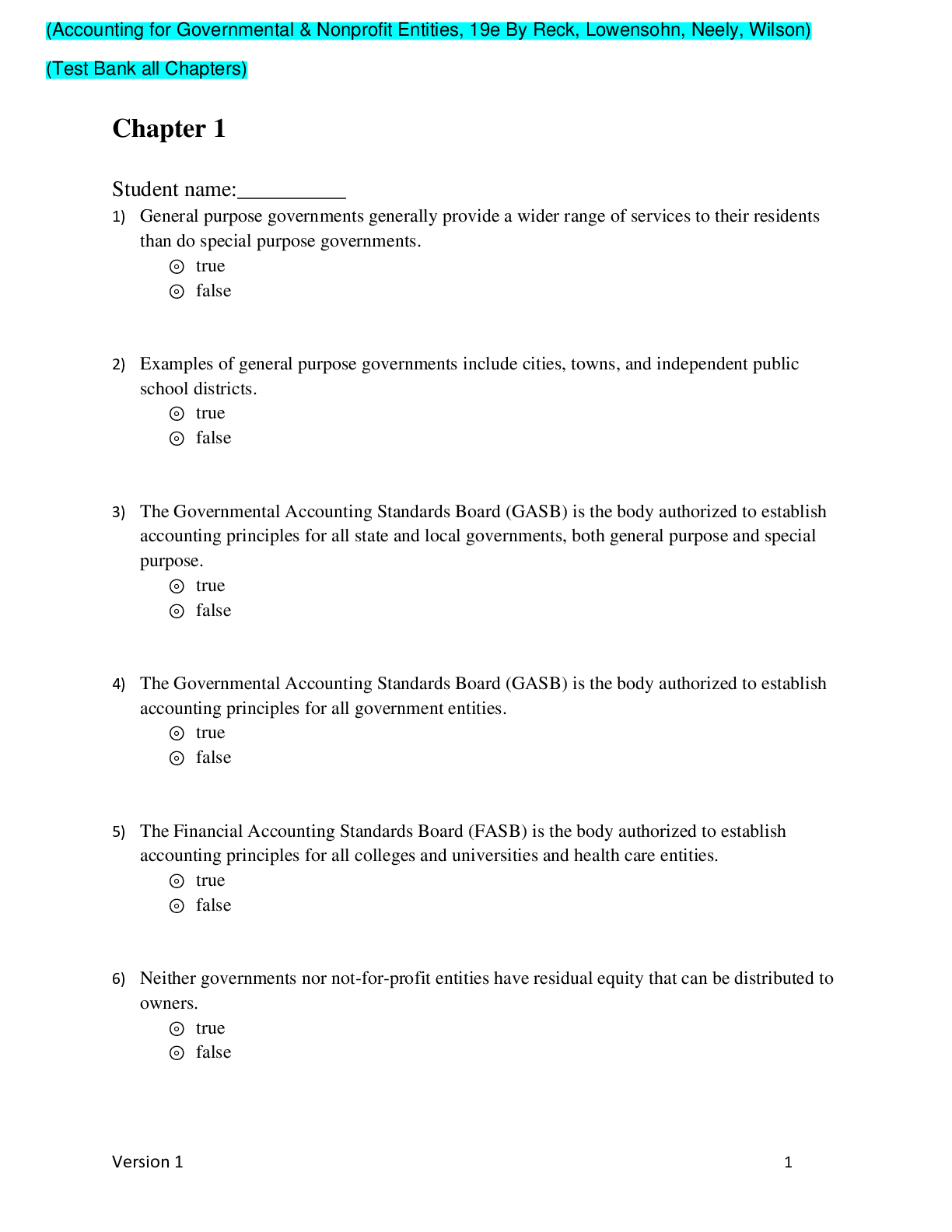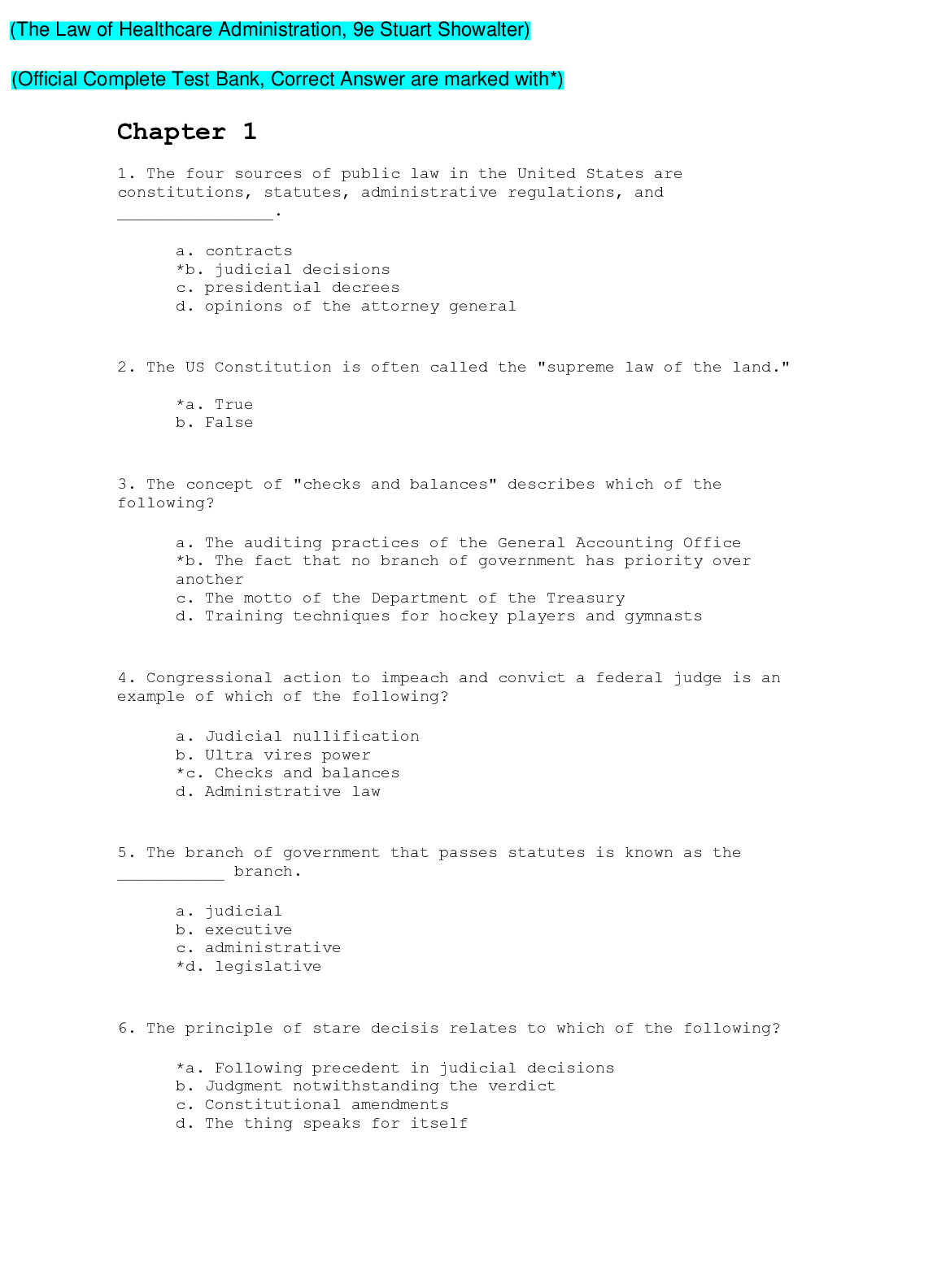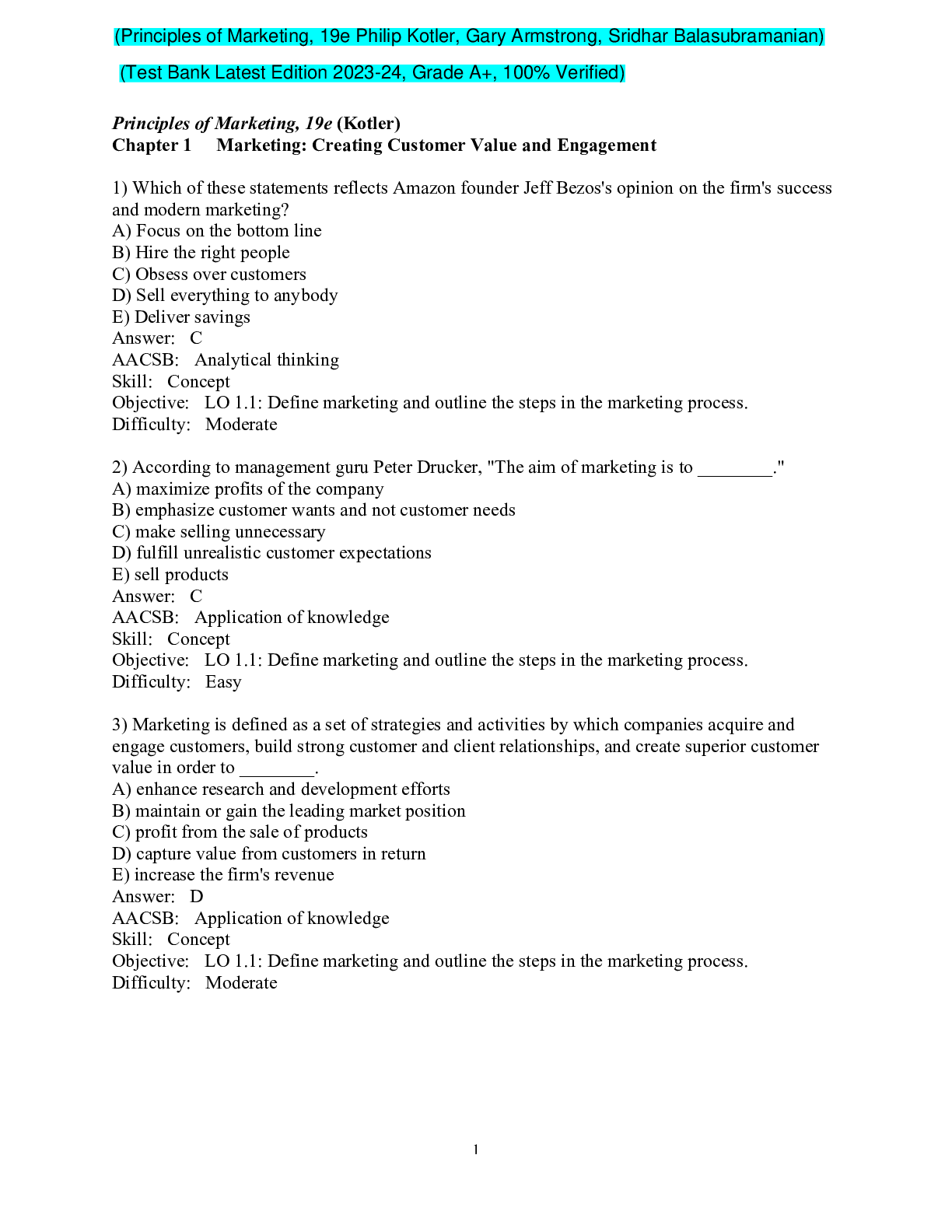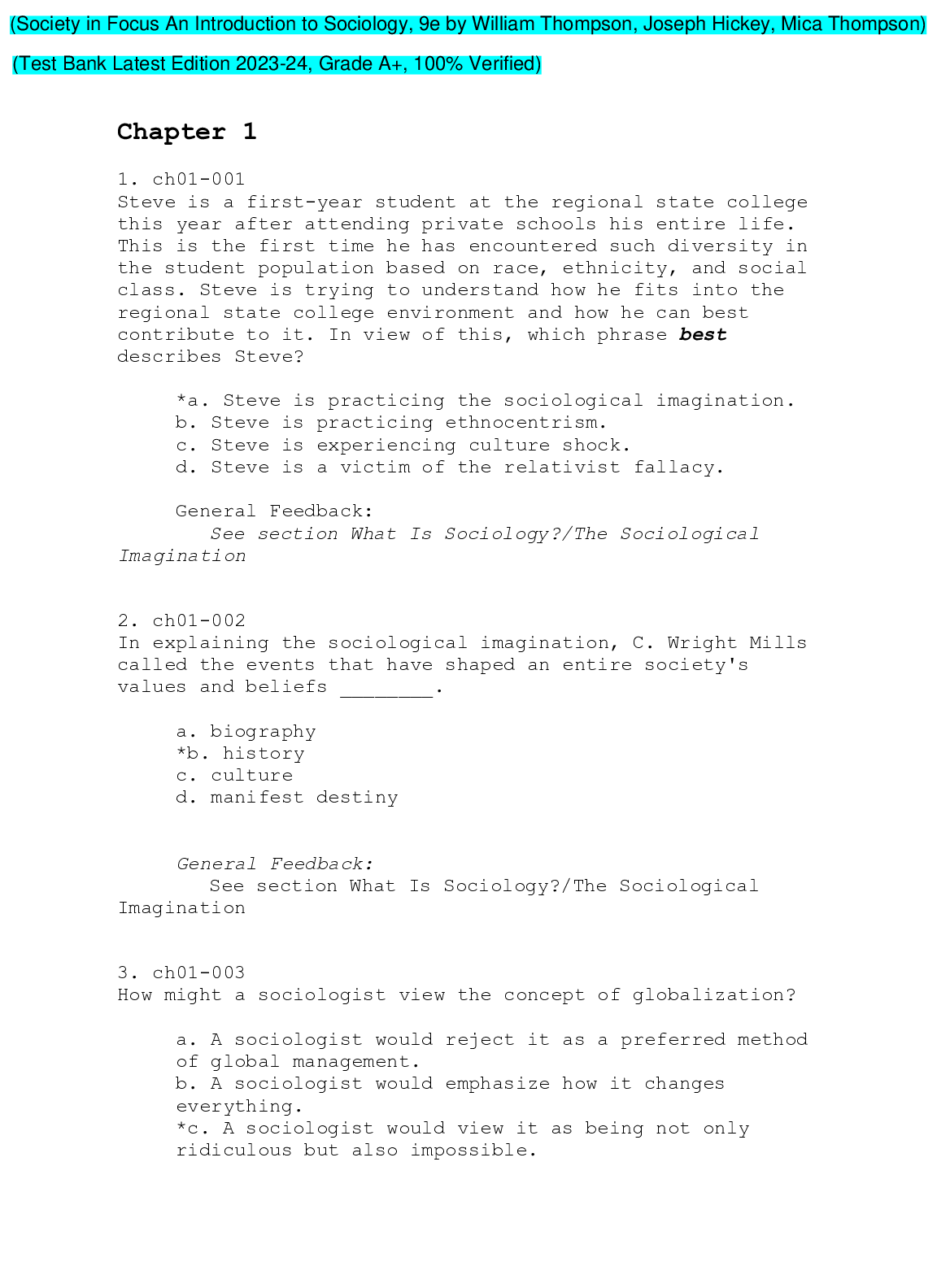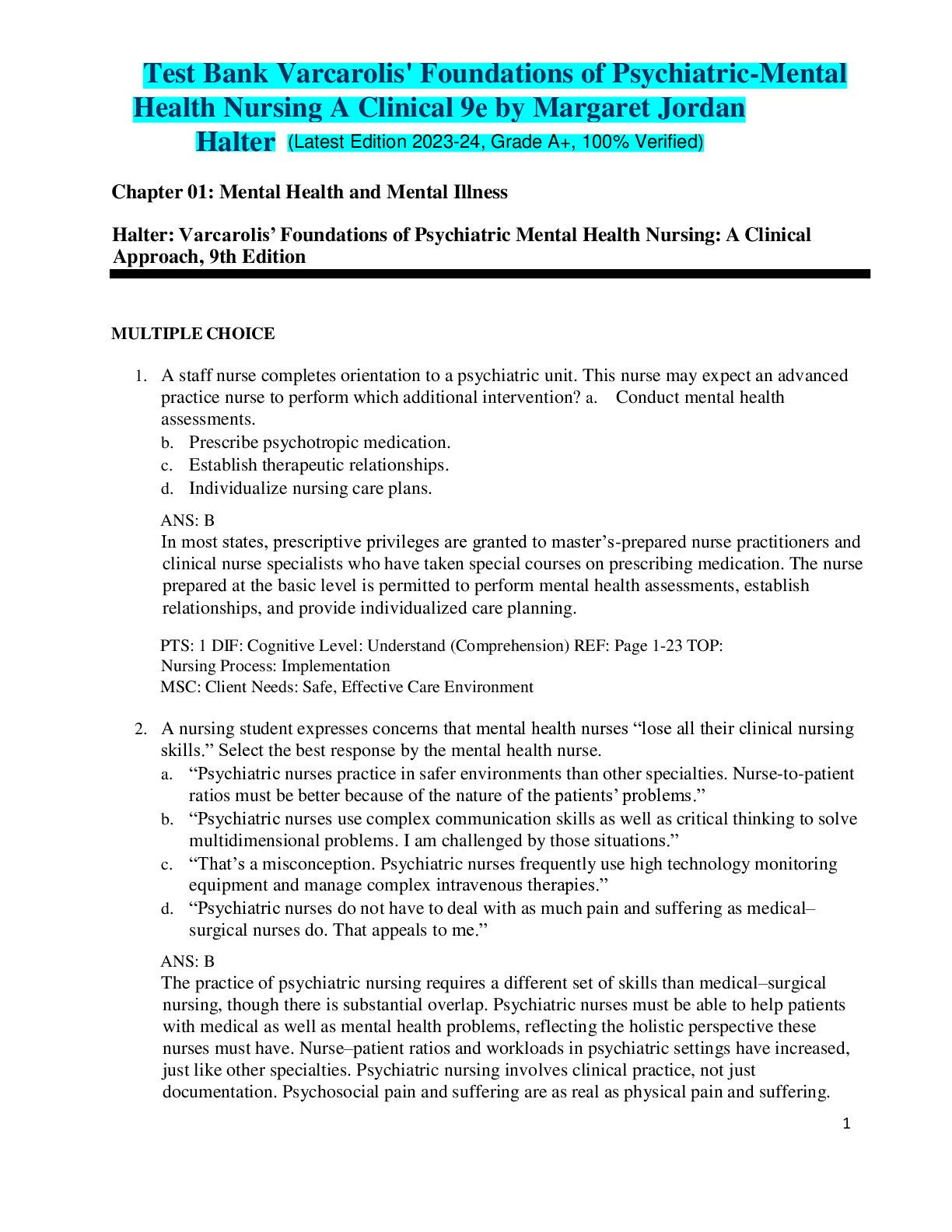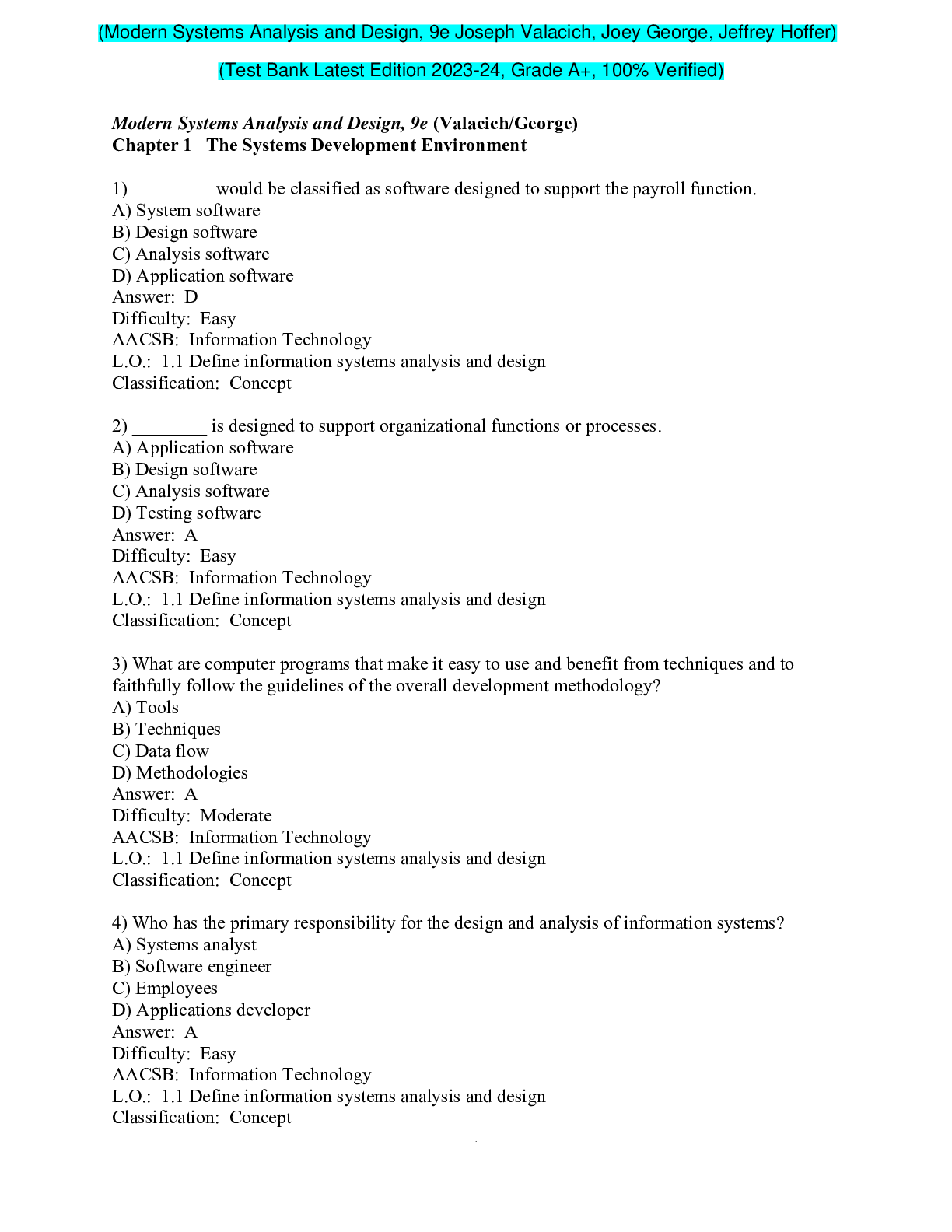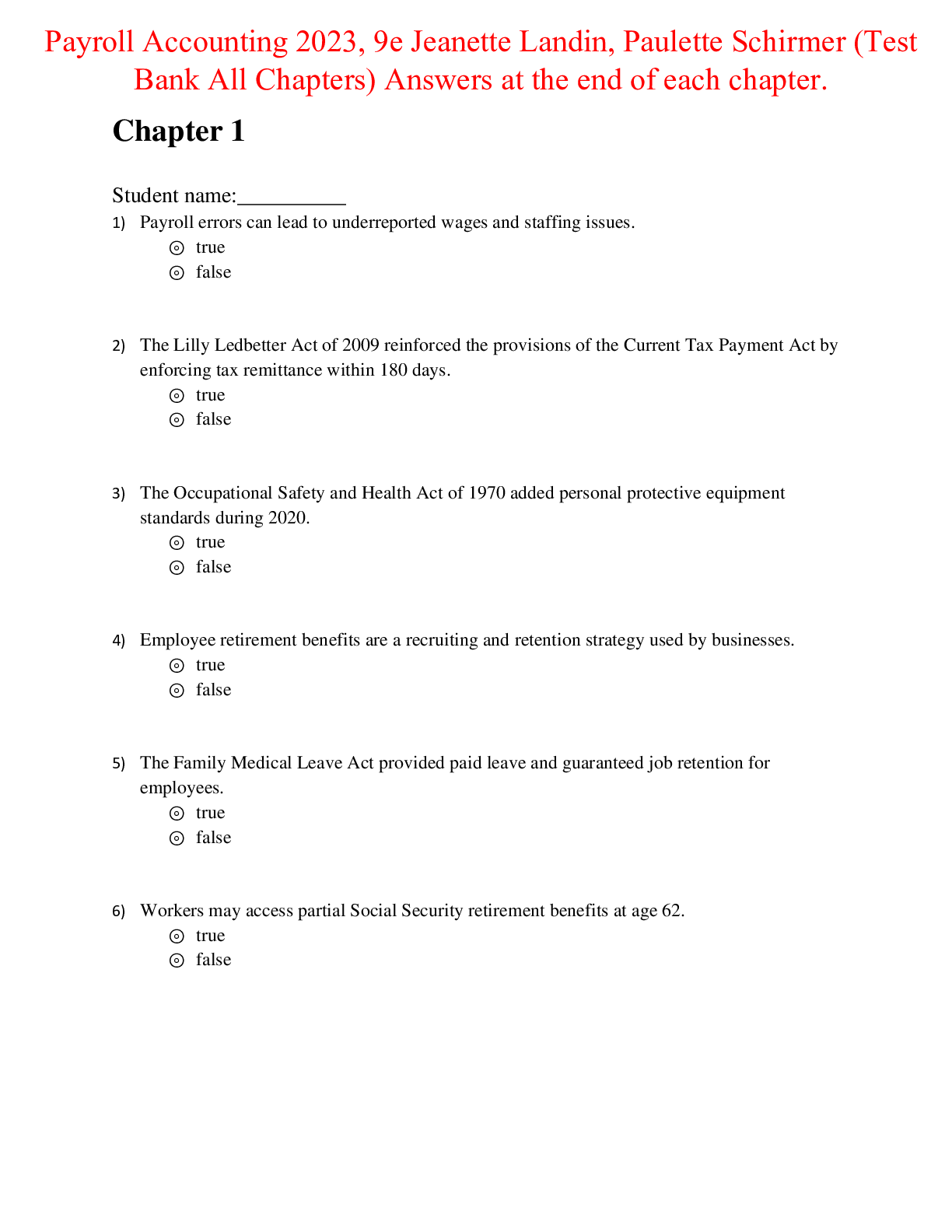Medical Studies > TEST BANK > MEDICAL SURGICAL NURSING- CONCEPTS FOR INTERPROFESSIONAL COLLABORATIVE CARE 9TH EDITION BY IGNATAVIC (All)
MEDICAL SURGICAL NURSING- CONCEPTS FOR INTERPROFESSIONAL COLLABORATIVE CARE 9TH EDITION BY IGNATAVICIUS_TEST BANK | 2022/2023
Document Content and Description Below
MEDICAL SURGICAL NURSING: CONCEPTS FOR INTERPROFESSIONAL COLLABORATIVE CARE 9TH EDITION IGNATAVICIUS TEST BANK Chapter 01: Overview of Professional Nursing Concepts for Medical- Surgical Nursing... MULTIPLE CHOICE 1. A nurse wishes to provide client-centered care in all interactions. Which action by the nurse best demonstrates this concept? a. Assesses for cultural influences affecting health care b. Ensures that all the clients basic needs are met c. Tells the client and family about all upcoming tests d. Thoroughly orients the client and family to the room ANS: A Competency in client-focused care is demonstrated when the nurse focuses on communication, culture, respect compassion, client education, and empowerment. By assessing the effect of the clients culture on health care, this nurse is practicing client-focused care. Providing for basic needs does not demonstrate this competence. Simply telling the client about all upcoming tests is not providing empowering education. Orienting the client and family to the room is an important safety measure, but not directly related to demonstrating client-centered care. DIF: Understanding/Comprehension REF: 3 KEY: Patient-centered care| culture MSC: Integrated Process: Caring NOT: Client Needs Category: Psychosocial Integrity 2. A nurse is caring for a postoperative client on the surgical unit. The clients blood pressure was 142/76 mm Hg 30 minutes ago, and now is 88/50 mm Hg. What action by the nurse is best? a. Call the Rapid Response Team. b. Document and continue to monitor. c. Notify the primary care provider. d. Repeat blood pressure measurement in 15 minutes. ANS: A The purpose of the Rapid Response Team (RRT) is to intervene when clients are deteriorating before they suffer either respiratory or cardiac arrest. Since the client has manifested a significant change, the nurse should call the RRT. Changes in blood pressure, mental status, heart rate, and pain are particularly significant. Documentation is vital, but the nurse must do more than document. The primary care provider should be notified, but this is not the priority over calling the RRT. The clients blood pressure should be reassessed frequently, but the priority is getting the rapid care to the client. DIF: Applying/Application REF: 3 KEY: Rapid Response Team (RRT)| medical emergencies MSC: Integrated Process: Communication and Documentation NOT: Client Needs Category: Physiological Integrity: Physiological Adaptation 3. A nurse is orienting a new client and family to the inpatient unit. What information does the nurse provide to help the client promote his or her own safety? a. Encourage the client and family to be active partners. b. Have the client monitor hand hygiene in caregivers. c. Offer the family the opportunity to stay with the client. d. Tell the client to always wear his or her armband. ANS: A Each action could be important for the client or family to perform. However, encouraging the client to be active in his or her health care as a partner is the most critical. The other actions are very limited in scope and do not provide the broad protection that being active and involved does. DIF: Understanding/Comprehension REF: 3 KEY: Patient safety MSC: Integrated Process: Teaching/Learning NOT: Client Needs Category: Safe and Effective Care Environment: Safety and Infection Control 4. A new nurse is working with a preceptor on an inpatient medical-surgical unit. The preceptor advises the student that which is the priority when working as a professional nurse? a. Attending to holistic client needs b. Ensuring client safety c. Not making medication errors d. Providing client-focused care ANS: B All actions are appropriate for the professional nurse. However, ensuring client safety is the priority. Up to 98,000 deaths result each year from errors in hospital care, according to the 2000 Institute of Medicine report. Many more clients have suffered injuries and less serious outcomes. Every nurse has the responsibility to guard the clients safety. DIF: Understanding/Comprehension REF: 2 KEY: Patient safety MSC: Integrated Process: Nursing Process: Intervention NOT: Client Needs Category: Safe and Effective Care Environment: Safety and Infection Control 5. A client is going to be admitted for a scheduled surgical procedure. Which action does the nurse explain is the most important thing the client can do to protect against errors? a. Bring a list of all medications and what they are for. b. Keep the doctors phone number by the telephone. c. Make sure all providers wash hands before entering the room. d. Write down the name of each caregiver who comes in the room. ANS: A Medication errors are the most common type of health care mistake. The Joint Commissions Speak Up campaign encourages clients to help ensure their safety. One recommendation is for clients to know all their medications and why they take them. This will help prevent medication errors. DIF: Applying/Application REF: 4 KEY: Speak Up campaign| patient safety MSC: Integrated Process: Teaching/Learning NOT: Client Needs Category: Safe and Effective Care Environment: Safety and Infection Control 6. Which action by the nurse working with a client best demonstrates respect for autonomy? a. Asks if the client has questions before signing a consent b. Gives the client accurate information when questioned c. Keeps the promises made to the client and family d. Treats the client fairly compared to other clients ANS: A Autonomy is self-determination. The client should make decisions regarding care. When the nurse obtains a signature on the consent form, assessing if the client still has questions is vital, because without full information the client cannot practice autonomy. Giving accurate information is practicing with veracity. Keeping promises is upholding fidelity. Treating the client fairly is providing social justice. DIF: Applying/Application REF: 4 KEY: Autonomy| ethical principles MSC: Integrated Process: Caring NOT: Client Needs Category: Safe and Effective Care Environment: Management of Care 7. A student nurse asks the faculty to explain best practices when communicating with a person from the lesbian, gay, bisexual, transgender, and queer/questioning (LGBTQ) community. What answer by the faculty is most accurate? a. Avoid embarrassing the client by asking questions. b. Dont make assumptions about their health needs. c. Most LGBTQ people do not want to share information. d. No differences exist in communicating with this population. ANS: B Many members of the LGBTQ community have faced discrimination from health care providers and may be reluctant to seek health care. The nurse should never make assumptions about the needs of members of this population. Rather, respectful questions are appropriate. If approached with sensitivity, the client with any health care need is more likely to answer honestly. DIF: Understanding/Comprehension REF: 4 KEY: LGBTQ| diversity MSC: Integrated Process: Teaching/Learning NOT: Client Needs Category: Psychosocial Integrity 8. A nurse is calling the on-call physician about a client who had a hysterectomy 2 days ago and has pain that is unrelieved by the prescribed narcotic pain medication. Which statement is part of the SBAR format for communication? a. A: I would like you to order a different pain medication. b. B: This client has allergies to morphine and codeine. c. R: Dr. Smith doesnt like nonsteroidal anti-inflammatory meds. d. S: This client had a vaginal hysterectomy 2 days ago. ANS: B SBAR is a recommended form of communication, and the acronym stands for Situation, Background, Assessment, and Recommendation. Appropriate background information includes allergies to medications the on-call physician might order. Situation describes what is happening right now that must be communicated; the clients surgery 2 days ago would be considered background. Assessment would include an analysis of the clients problem; asking for a different pain medication is a recommendation. Recommendation is a statement of what is needed or what outcome is desired; this information about the surgeons preference might be better placed in background. DIF: Applying/Application REF: 5 KEY: SBAR| communication MSC: Integrated Process: Communication and Documentation NOT: Client Needs Category: Safe and Effective Care Environment: Management of Care 9. A nurse working on a cardiac unit delegated taking vital signs to an experienced unlicensed assistive personnel (UAP). Four hours later, the nurse notes the clients blood pressure is much higher than previous readings, and the clients mental status has changed. What action by the nurse would most likely have prevented this negative outcome? a. Determining if the UAP knew how to take blood pressure b. Double-checking the UAP by taking another blood pressure c. Providing more appropriate supervision of the UAP d. Taking the blood pressure instead of delegating the task ANS: C Supervision is one of the five rights of delegation and includes directing, evaluating, and following up on delegated tasks. The nurse should either have asked the UAP about the vital signs or instructed the UAP to report them right away. An experienced UAP should know how to take vital signs and the nurse should not have to assess this at this point. Double-checking the work defeats the purpose of delegation. Vital signs are within the scope of practice for a UAP and are permissible to delegate. The only appropriate answer is that the nurse did not provide adequate instruction to the UAP. DIF: Applying/Application REF: 6 KEY: Supervision| delegation| unlicensed assistive personnel MSC: Integrated Process: Communication and Documentation NOT: Client Needs Category: Safe and Effective Care Environment: Management of Care 10. A nurse is talking with a client who is moving to a new state and needs to find a new doctor and hospital there. What advice by the nurse is best? a. Ask the hospitals there about standard nurse-client ratios. b. Choose the hospital that has the newest technology. c. Find a hospital that is accredited by The Joint Commission. d. Use a facility affiliated with a medical or nursing school. ANS: C Accreditation by The Joint Commission (TJC) or other accrediting body gives assurance that the facility has a focus on safety. Nurse-client ratios differ by unit type and change over time. New technology doesnt necessarily mean the hospital is safe. Affiliation with a health professions school has several advantages, but safety is most important. DIF: Understanding/Comprehension REF: 2 KEY: The Joint Commission (TJC)| accreditation MSC: Integrated Process: Communication and Documentation NOT: Client Needs Category: Safe and Effective Care Environment: Safety and Infection Control [Show More]
Last updated: 11 months ago
Preview 1 out of 1224 pages

Reviews( 0 )
Document information
Connected school, study & course
About the document
Uploaded On
Sep 03, 2021
Number of pages
1224
Written in
Additional information
This document has been written for:
Uploaded
Sep 03, 2021
Downloads
0
Views
58

